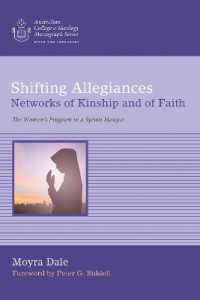Full Description
This book presents realistic alternatives to security policies based on nuclear weapons for the Northeast Asian region.
Northeast Asian governments and populations feel less secure than ever, and the governments of the USA, Russia, China, and North Korea are all expending considerable resources on increasing their nuclear arsenals. This book presents realistic alternatives to security policies dependent on threats to use nuclear weapons and demonstrations of the resolve to use them in a war. Those alternatives are grounded in the well-established concept of common security. The long-term goal of these alternatives is the establishment of a nuclear-weapon-free zone in Northeast Asia. This book demonstrates that lessons learned during the creation of existing nuclear-weapon-free zones can be successfully adapted, using the proposed alternatives to nuclear threats, to the considerably more challenging circumstances that exist in contemporary Northeast Asia. More importantly, it makes the case that the mere process of pursuing this objective, even if the goal is not realized for many decades, would help facilitate regional risk-reduction measures and global nuclear arms control measures that could lead, in the long term, to the general and complete disarmament promised by the Nuclear Nonproliferation Treaty (NPT) and the Treaty on the Prohibition of Nuclear Weapons (TPNW) of 2021. This book will be of interest to students of nuclear proliferation, Asian security, foreign policy, and International Relations.
Contents
Part I: Introduction Chapter 1. An Opening for Regional Denuclearization: Executive Introduction Part II: Connecting Past Practice to Current Problems Chapter 2. The US-China Competition Is Going Nuclear: Deadlock on Thin Ice Chapter 3. A Nuclear-Weapons-Free Zone in Northeast Asia: From a Japanese Security Perspective Chapter 4. Changing Security Dynamics in the Korean Peninsula: Rising Strategic Competition, Destabilizing Balance of Terror Chapter 5. The Mongolian Miracle: From Buffer to Beacon Part III: The Path to Denuclearization: Risk Reduction through Common Security Chapter 6. Revisiting the Comprehensive Security Roadmap To Reduce the Risk of War on the Korean Peninsula Chapter 7. Reconsidering Extended Nuclear Deterrence: Inherent Flaws Within Chapter 8. Rationale for a NWFZ in Northeast Asia Leading to Global Nuclear Disarmament: A Viewpoint from International Law Chapter 9: Getting to Zero in Korea: Weathered Carriage on a Viable Path Chapter 10. Civil Society Initiatives for Establishing a Northeast Asia Nuclear Weapon-Free Zone: Focusing on Debates in the Japanese Diet Part IV: Conclusion Chapter 11. Toward a Secure Northeast Asia without Nuclear Weapons: Proposing NWFZ 2.0 and a C3 Security Regime






